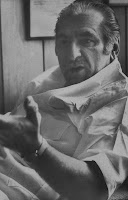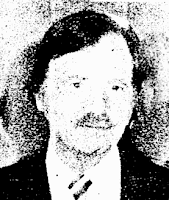Ketchum who kept abortion instruments in his house and perpetrated abortions in a motel room. Clergy Consultation Services (CCS), an organization created specifically to refer women to abortionists, began referring women to him.
In late 1969 or early 1970, Ketchum was arrested after an undercover policewoman arranged for him to perform an abortion at a motel in Southfield, Michigan. She had been referred to Ketchum through Clergy Consultation Service.
The Michigan Women's Commission and CCS responded to Ketchum's arrest by starting a drive to repeal laws against abortion. County Prosecutor Thomas Plunkett objected to feeling forced to prosecute Ketchum because he, himself, favored abortion rights. Whether allowing the likes of Jesse Ketchum to ply the abortion trade without let or hindrance was not even taken into consideration by his supporters.
When New York legalized abortion on demand in 1970, 52-year-old Ketchum -- assisted by his wife, Judith, nearly 30 years his junior -- set up shop in a Buffalo motel suite. For Ketchum, New York must have seemed like the Promised Land. Abortionists were flaunting safety standards with impunity. Practices such as injecting patients with saline then sending them home to abort raised eyebrows, to be sure, but they didn't get anybody thrown in jail even if the woman died. CCS continued to refer women to Ketchum in his new location.
On May 28, 1971, Ketchum did a D&C abortion under general anesthesia on Ellen K. Lawler of New Baltimore, MI, in his Buffalo office. Only later, at an undisclosed time, did Mrs. Lawler discover that Ketchum had lacerated her uterus, anterior cul-de-sac, right broad ligament, and peritoneum. He had told her the abortion had been uncomplicated. Such severe injuries in a criminal abortion patient would have brought the heat down on our boy Jesse. But this was New York, abortion was legal, and although Mrs. Lawler suffered ill effects from Ketchum's foul-up, Ketchum himself was able to carry on.
Ketchum decided to do hysterotomy abortions -- which involve slicing the uterus open to remove the baby -- in his office. It didn't take long for this practice to turn deadly. In the second half of 1971, Ketchum caught the eyes of the authorities by allowing two hysterotomy patients to bleed to death.
His first victim was 25-year-old Margaret Smith, who had traveled from Ketchum's home state of Michigan to New York for a safe and legal abortion because she had been exposed to rubella. Ketchum performed a vaginal hysterotomy on Margaret at 10:30 the morning of June 16, 1971. Margaret was then left virtually unattended until her boyfriend returned at 2:00. He found Margaret unresponsive, and begged Ketchum and his staff to do something.
Paramedics were summoned, but they were unable to revive Margaret. She was taken to a hospital across the street from Ketchum's office, where she was pronounced dead on arrival. Margaret's vagina had been sutured, but a laceration in her uterus and cervix had not been repaired. She had bled to death. -- just across the street from a hospital that could have saved her life had Ketchum made the effort to monitor her. (Ketchum V. Ward No. Civ-75-79)
Ketchum was verily astounded when he was charged with criminally negligent homicide in Margaret Smith's death. Abortion, after all, was legal. How could one be prosecuted for doing something legal? And evidently he didn't think the state could possibly succeed in their case. He kept taking risks with patient's lives Before his case went to trial, he performed a similar abortion on 37-year-old Carole Schaner of Ohio on October 20, 1971. Carole was 14 weeks pregnant. After the abortion, Carole went into shock, and was taken to a hospital. Despite all efforts, Carole died before doctors could even fully assess the extent of her injuries. She left behind four children.
The autopsy found that Carole's cervix and uterus had been cut open, and an artery outside her uterus had been cut. It also noted sutures that had evidently been put in by Ketchum in an attempt to repair the damage. The sutures, however, completely closed Carole's cervix, allowing her to continue bleeding from the injured uterus and artery.
 |
| Dr. Milan Vuitch |
Ketchum served little time, however. He was released after less than a year, and relocated to Florida.
.
Ketchum had asked to take the test to become licensed in Florida but his request was denied. In spite of this, he found work at the University of Miami School of Medicine, at Jackson Memorial Hospital, and at the VA hospital in Miami, from September of 1976 to November of 1977. It turned out that no license was required for a doctor to practice in a government operated hospital.
In 1978, he and Judith divorced.
While at the Miami School of Medicine, Ketchum was administering oxygen to Mrs. M for routine surgery. Rather than the 40% oxygen he was to administer, Ketchum provided only 15%. Mrs. M failed to notice until Mrs. M had gone into a coma from which she still hadn't recovered after 19 months.
According to the medical board licensee lookup, Ketchum relocated to Michigan. His petitions to restore his medical license, made in 1984 and 1987, were both denied. Nevertheless, despite killing two women, he remained a free man until his death in 2005.
 |
| Dr. Benjamin Munson |
Legalization -- as we can see from these specific tragedies as well as from the numbers -- did nothing to protect women from dying at the hands of abortionists. If anything, it seemed to have emboldened them to take risks they never would have considered taking were a botched abortion alone enough to carry the risk of the loss of a medical license or even of freedom.
No comments:
Post a Comment